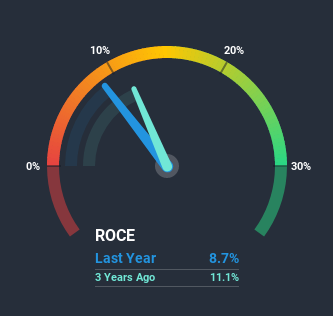The Trends At Escalade (NASDAQ:ESCA) That You Should Know About

What trends should we look for it we want to identify stocks that can multiply in value over the long term? Firstly, we'll want to see a proven return on capital employed (ROCE) that is increasing, and secondly, an expanding base of capital employed. Ultimately, this demonstrates that it's a business that is reinvesting profits at increasing rates of return. In light of that, when we looked at Escalade (NASDAQ:ESCA) and its ROCE trend, we weren't exactly thrilled.
Return On Capital Employed (ROCE): What is it?
For those that aren't sure what ROCE is, it measures the amount of pre-tax profits a company can generate from the capital employed in its business. Analysts use this formula to calculate it for Escalade:
Return on Capital Employed = Earnings Before Interest and Tax (EBIT) ÷ (Total Assets - Current Liabilities)
0.087 = US$11m ÷ (US$145m - US$15m) (Based on the trailing twelve months to March 2020).
Thus, Escalade has an ROCE of 8.7%. Ultimately, that's a low return and it under-performs the Leisure industry average of 14%.
View our latest analysis for Escalade
While the past is not representative of the future, it can be helpful to know how a company has performed historically, which is why we have this chart above. If you're interested in investigating Escalade's past further, check out this free graph of past earnings, revenue and cash flow.
What Can We Tell From Escalade's ROCE Trend?
On the surface, the trend of ROCE at Escalade doesn't inspire confidence. Around five years ago the returns on capital were 17%, but since then they've fallen to 8.7%. On the other hand, the company has been employing more capital without a corresponding improvement in sales in the last year, which could suggest these investments are longer term plays. It may take some time before the company starts to see any change in earnings from these investments.
On a side note, Escalade has done well to pay down its current liabilities to 11% of total assets. That could partly explain why the ROCE has dropped. Effectively this means their suppliers or short-term creditors are funding less of the business, which reduces some elements of risk. Some would claim this reduces the business' efficiency at generating ROCE since it is now funding more of the operations with its own money.
What We Can Learn From Escalade's ROCE
Bringing it all together, while we're somewhat encouraged by Escalade's reinvestment in its own business, we're aware that returns are shrinking. And with the stock having returned a mere 11% in the last five years to shareholders, you could argue that they're aware of these lackluster trends. So if you're looking for a multi-bagger, the underlying trends indicate you may have better chances elsewhere.
Escalade does have some risks though, and we've spotted 2 warning signs for Escalade that you might be interested in.
If you want to search for solid companies with great earnings, check out this free list of companies with good balance sheets and impressive returns on equity.
This article by Simply Wall St is general in nature. It does not constitute a recommendation to buy or sell any stock, and does not take account of your objectives, or your financial situation. We aim to bring you long-term focused analysis driven by fundamental data. Note that our analysis may not factor in the latest price-sensitive company announcements or qualitative material. Simply Wall St has no position in any stocks mentioned.
Have feedback on this article? Concerned about the content? Get in touch with us directly. Alternatively, email editorial-team@simplywallst.com.

 Yahoo News
Yahoo News 

